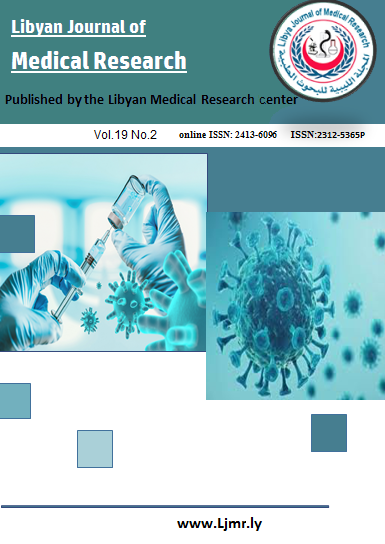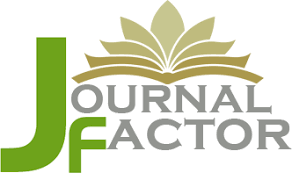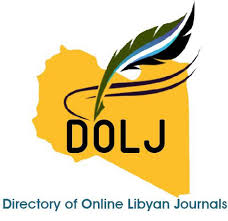Assessment of Serum Vitamin D and Calcium Levels among Patients with Hypothyroidism: A Comparative Study in Albayda, Libya
DOI:
https://doi.org/10.54361/LJMR.19.2.34Keywords:
Vitamin D, Calcium, Hypothyroidism, Hypovitaminosis D, AlbaydaAbstract
Purpose: Vitamin D is essential for the proper functioning of numerous organs, including the thyroid gland. Therefore, a deficiency in vitamin D is considered a potential risk factor for developing various thyroid disorders, particularly hypothyroidism. The present study aimed to evaluate the serum concentrations of vitamin D and calcium in individuals who have been diagnosed with hypothyroidism. Materials and Methods The research was conducted on a cohort of 150 patients with hypothyroidism at the Department of Internal Medicine, Albayda Medical Center, in Albayda, Libya. Serum levels of vitamin D, calcium, thyroid-stimulating hormone (TSH), and thyroid hormones (T3 and T4) were measured in all participants. A control group consisting of 100 healthy individuals was used for comparison. Vitamin D deficiency was defined as serum vitamin D concentrations below 20 ng/mL. Results: Our findings indicated that patients with hypothyroidism exhibited significantly reduced serum levels of both vitamin D and calcium compared to the control group (P<0.05). Conclusion: Based on these results, it is strongly advised that individuals with hypothyroidism be screened for vitamin D and calcium deficiencies and, if necessary, receive appropriate supplementation.
Downloads
References
1. Holick M. F. (1987). Photosynthesis of vitamin D in the skin: effect of environmental and life-style variables. Federation proceedings, 46(5), 1876–1882.
2. Dominguez, L. J., Farruggia, M., Veronese, N., & Barbagallo, M. (2021). Vitamin D Sources, Metabolism, and Deficiency: Available Compounds and Guidelines for Its Treatment. Metabolites, 11(4), 255.
3. Chung, M., Balk, E. M., Brendel, M., Ip, S., Lau, J., Lee, J., Lichtenstein, A., Patel, K., Raman, G., Tatsioni, A., Terasawa, T., & Trikalinos, T. A. (2009). Vitamin D and calcium: a systematic review of health outcomes. Evidence report/technology assessment, (183), 1–420.
4. Khakisahneh, S., Zhang, X. Y., Nouri, Z., Hao, S. Y., Chi, Q. S., & Wang, D. H. (2019). Thyroid hormones mediate metabolic rate and oxidative, anti-oxidative balance at different temperatures in Mongolian gerbils (Meriones unguiculatus). Comparative biochemistry and physiology. Toxicology & Pharmacology: CBP, 216, 101–109.
5. Duran, İ. D., Gülçelik, N. E., Bulut, B., Balcı, Z., Berker, D., & Güler, S. (2019). Differences in Calcium Metabolism and Thyroid Physiology After Sleeve Gastrectomy and Roux-En-Y Gastric Bypass. Obesity surgery, 29(2), 705–712.
6. Unnikrishnan, A. G., Kalra, S., Sahay, R. K., Bantwal, G., John, M., & Tewari, N. (2013). Prevalence of hypothyroidism in adults: An epidemiological study in eight cities of India. Indian journal of endocrinology and metabolism, 17(4), 647–652.
7. Kivity, S., Agmon-Levin, N., Zisappl, M., Shapira, Y., Nagy, E. V., Dankó, K., Szekanecz, Z., Langevitz, P., & Shoenfeld, Y. (2011). Vitamin D and autoimmune thyroid diseases. Cellular & molecular immunology, 8(3), 243–247.
8. Tamer, G., Arik, S., Tamer, I., & Coksert, D. (2011). Relative vitamin D insufficiency in Hashimoto's thyroiditis. Thyroid: official journal of the American Thyroid Association, 21(8), 891–896.
9. Yasuda, T., Okamoto, Y., Hamada, N., Miyashita, K., Takahara, M., Sakamoto, F., Miyatsuka, T., Kitamura, T., Katakami, N., Kawamori, D., Otsuki, M., Matsuoka, T. A., Kaneto, H., & Shimomura, I. (2012). Serum vitamin D levels are decreased and associated with thyroid volume in female patients with newly onset Graves' disease. Endocrine, 42(3), 739–741.
10. Zhou, H., Xu, C., & Gu, M. (2009). Vitamin D receptor (VDR) gene polymorphisms and Graves' disease: a meta-analysis. Clinical endocrinology, 70(6), 938–945.
11. Appunni, S., Rubens, M., Ramamoorthy, V., Saxena, A., Tonse, R., Veledar, E., & McGranaghan, P. (2021). Association between vitamin D deficiency and hypothyroidism: results from the National Health and Nutrition Examination Survey (NHANES) 2007-2012. BMC endocrine disorders, 21(1), 224.
12. Kaplan M. M. (1999). Clinical perspectives in the diagnosis of thyroid disease. Clinical chemistry, 45(8 Pt 2), 1377–1383.
13. Al-Ali, A., AlElq, A., Al-Turki, H., Al-Mulhim, F., & Sadat-Ali, M. (2009). Vitamin D levels in healthy men in eastern Saudi Arabia. Annals of Saudi medicine, 29(5), 378–382.
14. Mackawy, A. M., Al-Ayed, B. M., & Al-Rashidi, B. M. (2013). Vitamin D deficiency and its association with thyroid disease. Int J Health Sci (Qassim), 7(3):267-75.
15. Elsammak, M. Y., Al-Wossaibi, A. A., Al-Howeish, A., & Alsaeed, J. (2011). High prevalence of vitamin D deficiency in the sunny Eastern region of Saudi Arabia: a hospital-based study. Eastern Mediterranean health journal, 17(4), 317–322.
16. Lippi, G., Montagnana, M., Meschi, T., & Borghi, L. (2012). Vitamin D concentration and deficiency across different ages and genders. Aging clinical and experimental research, 24(5), 548–551.
17. Hashemipour, S., Larijani, B., Adibi, H., Javadi, E., Sedaghat, M., Pajouhi, M., Soltani, A., Shafaei, A. R., Hamidi, Z., Fard, A. R., Hossein-Nezhad, A., & Booya, F. (2004). Vitamin D deficiency and causative factors in the population of Tehran. BMC public health, 4, 38.
18. Heshmat, R. Y., Mohammad, K. M., & Ranjbar, G. H. (2008). Vitamin D deficiency in Iran: A multi-center study among different urban areas. Iran J Public Health, 37(suppl): 72-8.
19. Salman, S., Khouzami, M., Harb, M., Saleh, B., Boushnak, M. O., Moussa, M. K., & Mohsen, Z. H. (2021). Prevalence and Predictors of Vitamin D Inadequacy: A Sample of 2,547 Patients in a Mediterranean Country. Cureus, 13(5), e14881.
20. Faid, F. E., Alsheekh, A. M., Abais, M. F., & Eljamay, S. M. (2024). Vitamin D Deficiency Relationship with Age and Gender. Derna Academy Journal for Applied Sciences, 3(2), 153-160.
Downloads
Published
Issue
Section
License
Copyright (c) 2025 Nusieba A. Ibrahim, Yahya Saber E. Mansour (Author)

This work is licensed under a Creative Commons Attribution-NonCommercial-NoDerivatives 4.0 International License.
Open Access Policy
Libyan journal of medical Research (LJMR).is an open journal, therefore there are no fees required for downloading any publication from the journal website by authors, readers, and institution.
The journal applies the license of CC BY (a Creative Commons Attribution 4.0 International license). This license allows authors to keep ownership f the copyright of their papers. But this license permits any user to download , print out, extract, reuse, archive, and distribute the article, so long as appropriate credit is given to the authors and the source of the work.
The license ensures that the article will be available as widely as possible and that the article can be included in any scientific archive.
Editorial Policy
The publication of an article in a peer reviewed journal is an essential model for Libyan journal of medical Research (LJMR). It is necessary to agree upon standards of expected ethical behavior for all parties involved in the act of publishing: the author, the journal editorial, the peer reviewer and the publisher.
Any manuscript or substantial parts of it, submitted to the journal must not be under consideration by any other journal. In general, the manuscript should not have already been published in any journal or other citable form, although it may have been deposited on a preprint server. Authors are required to ensure that no material submitted as part of a manuscript infringes existing copyrights, or the rights of a third party.
Authorship Policy
The manuscript authorship should be limited to those who have made a significant contribution and intellectual input to the research submitted to the journal, including design, performance, interpretation of the reported study, and writing the manuscript. All those who have made significant contributions should be listed as co-authors.
Others who have participated in certain substantive aspects of the manuscript but without intellectual input should only be recognized in the acknowledgements section of the manuscript. Also, one of the authors should be selected as the corresponding author to communicate with the journal and approve the final version of the manuscript for publication in the LJMR.
Peer-review Policy
- All the manuscripts submitted to LJMR will be subjected to the double-blinded peer-review process;
- The manuscript will be reviewed by two suitable experts in the respective subject area.
- Reports of all the reviewers will be considered while deciding on acceptance/revision or rejection of a manuscript.
- Editor-In-Chief will make the final decision, based on the reviewer’s comments.
- Editor-In-Chief can ask one or more advisory board members for their suggestions upon a manuscript, before making the final decision.
- Associate editor and review editors provide administrative support to maintain the integrity of the peer-review process.
- In case, authors challenge the editor’s negative decision with suitable arguments, the manuscript can be sent to one more reviewer and the final decision will be made based upon his recommendations.














